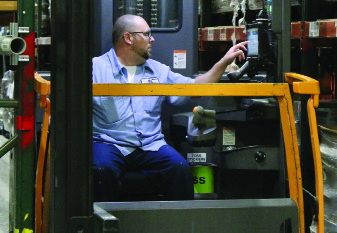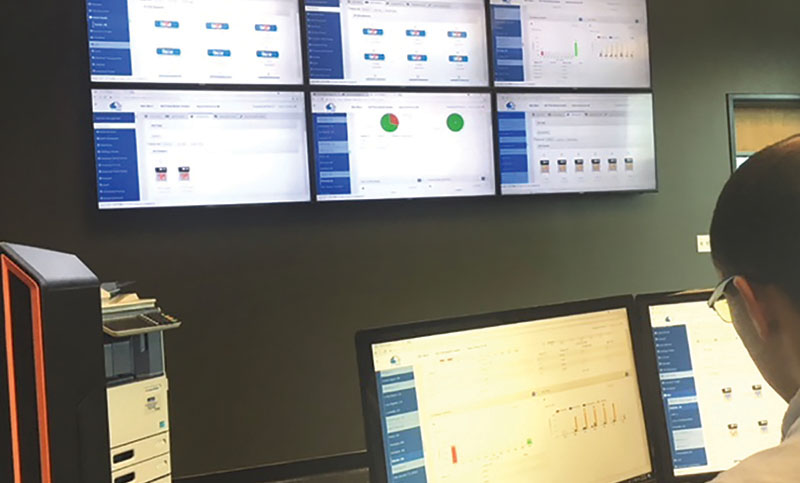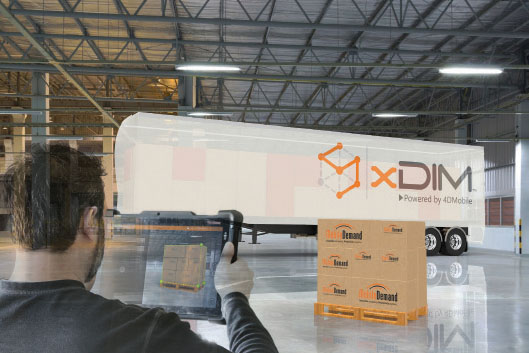Technology on Lift Trucks
On-board terminals and battery management systems are becoming central to maximizing daily productivity of lift trucks as well as long-term fleet efficiencies. Learn how technology on lift trucks is becoming integral to help fleet managers plan not just today’s activities and fleet deployment but long-term fleet needs.
In case you haven’t noticed, a new wave of tech for lift trucks is here—onboard terminals and digitally monitored battery management systems. You’ve likely noticed the former, but the latter is just emerging. Taken together, they are about to have a strong impact on your operations.
Both technologies contribute directly to day-to-day productivity. And, they both deliver a direct impact on right-sizing lift truck fleets now and into the future. In other words, both tech tools are ready to help fleet managers plan not just today’s activities and fleet deployment but long-term fleet needs.
On-board terminals continue to appear in new form factors including tablets and other mobile devices, no longer mounted once and forever on the truck. That’s introduced a new level of flexibility and agility that directly contributes to productivity.
Digital battery management systems, however, are a tech tool at its earliest stages of development. After all, when was the last time you thought about software and the Cloud when it came to battery management? Probably never.
“The charging game is changing,” explains Mike Nelson, general manager of Advanced Charging Technologies (ACT). “The trend is to have real-time views of battery status and use to maximize daily operational efficiencies of lift trucks as well as longer term,” he adds.
Similarly, terminals on trucks are becoming increasingly critical to maximizing lift truck efficiencies. No one needs underutilized trucks or ones that deliver the wrong parts to the wrong locations. Data transmitted from enterprise systems to onboard terminals directly determine how effectively (travel- and inventory-wise) any truck moves about the facility. Longer term, it helps determine the types of trucks and numbers needed to meet actual and future work levels.
While the tech has changed, so have two factors critical to tech’s future success.
“We are finally past the point of fleet managers buying technology without knowing its value to the business,” explains John E. Chis, vice president of sales and marketing at terminal supplier MobileDemand. And while he was speaking about terminals, the same is true for battery charging, too. In fact, fleet managers are looking for specific performance enhancements when evaluating any new technology.
Chis cites another critical shift in how company departments work together that has paved the way for tech on trucks. Gone are the days when IT made all technology decisions regardless of what operations needed or wanted. As he explains, “everyone now has mutual interests that the technology deployed works for everyone.”
Terminals: Tip of the spear
 “Mobile computing is the tip of the spear when it comes to bringing operational information to the lift truck driver today,” says Chis. He cites a recent success at commercial printer Japs-Olson as an example.
“Mobile computing is the tip of the spear when it comes to bringing operational information to the lift truck driver today,” says Chis. He cites a recent success at commercial printer Japs-Olson as an example.
“We needed to better move material throughout the plant. We wanted to minimize forklifts that were driving around with empty forks and maximize their ability to move material throughput the plant,” says Chris Peddicord at Japs-Olson. By the way, he’s the company’s director of enterprise technology and compliance, but he talks like an operations manager.
Meanwhile, Nick Lethert, Japs-Olson warehouse manager, explains that Wi-Fi connectivity issues and poor performance were a problem with their original forklift-mounted computers. “It was affecting accurate placement of inventory in different areas, and it was creating a lot of inaccuracies,” says Lethert. Sounds like the operations manager understands technology issues, too.
The solution was new lift truck mounted tablets (MobileDemand) with sufficient Wi-Fi connection throughout the 525,000-square-foot warehouse for the 30-truck fleet. The 11.6-inch rugged Windows tablets are now always connected to the company’s existing enterprise software. Without the previous data losses, productivity and efficiency have improved, adding value to the business.
Today, terminal mobility comes in many different forms. Computers permanently mounted on lift trucks are not going away. But, they clearly are being augmented by tablets and smaller devices, sometimes even on phones, that sit in the mount some of the time as well as off the truck with the operator. Typically, these devices are ruggedized for use in plants and warehouses.
It sounds simple enough, but selection and startup of mobile devices of all types requires some work. To be most effective, it requires true collaboration between IT and operations, explains Tom O’Brien, materials handling and logistics sales manager of terminal mount supplier Gamber-Johnson.
“The IT team that’s ordering the technology ensures it will connect with the infrastructure in the warehouse or DC, while not really understanding the equipment mounting and operator training that has to take place to make the investment worthwhile,” says O’Brien. That’s where collaboration with operations pays off to ensure the technology doesn’t become “a burden versus an efficiency booster,” he adds.
Because that efficiency comes in many different form factors, mounts are critical. After all, there’s not only a difference between the computer’s form factor but the intention to leave it on the truck or be removed as needed. Ergonomics are part of the equation, too.
Mounts are of significant importance here, explains Gamber-Johnson’s product marketer Brian Demski. “Mounts, just like terminals, have to be rugged, reliable and responsive,” he says.
Demski says the answers to four questions are critical:
- Exactly what device is being mounted?
- What model vehicle is the device being mounted to?
- What is the vehicle’s voltage?
- What accessories need to be mounted?
The first consideration takes into account the dock/cradle/mount required for the specific application and desired connectivity. Quite simply, the mount and the device must be paired quite precisely.
The second focuses on selecting the right mounting solution for the specific lift truck. This addresses not just the structure of the lift truck cage, but the ergonomics of terminal accessibility for operators.
The voltage of the lift truck takes into account the power supply and how well it’s matched to the needs of the device. Too little voltage is never good.
Accessories range from keyboards to printers and bar code readers along with other peripherals desired on the lift truck. And peripherals are still proliferating. MobileDemand introduced a mobile volume dimensioning system, xDim, at the ProMat show earlier this year.
Using a 3-D camera, the tablet-based system brings dimensioning technology to the shipping package rather than the other way around, explains Chis. He says it’s especially effective at dimensioning packages to ensure highly efficient space usage in tight staging areas near the dock as well as on over-the road trucks.
Battery management in the Cloud
Then, there’s the matter of digital battery management systems. The basic concept is to have lead acid batteries ready to run for a shift at the start of every shift. Sounds simple, but oftentimes it requires some orchestration, that’s not always successful.
For instance, batteries may not have made it to the charging room. They may not be fully charged on schedule. More trucks may be required for the day’s workload than batteries are available.
Fortunately, remote battery management systems are coming to the rescue. To begin, they monitor and manage battery-charging activities, often using the Cloud to store information and Wi-Fi to share that data across the facility. This way fleet managers know remotely which batteries are ready to go and when.
With the accumulation of this data over time, fleet managers are in a position to use specific batteries based on actual usage data, extending battery life. Some systems are even able to model battery needs for fleets into the future.

Remote battery management using the Cloud allows fleet managers to monitor battery charging activities and individual batteries.
One system is the ACT intelligent data and asset management platform from Advanced Charging Technologies. As Nelson explains, the system has multiple capabilities. These start with a Cloud-based data portal that remotely monitors, analyzes and controls charging down to the specific battery and charging equipment. For battery rooms, ACTfirst, a battery room management system, assigns scores to batteries to determine which is most ready for use at any given time. Additional capabilities are available, too.
“The focus of all our platform is to remotely collect and analyze data to make it actionable and improve lift truck efficiency through more effective battery management,” says Nelson.
At ProMat earlier this year, Exide Technologies launched GNB Cloud, says John Aker, vice president of worldwide charger development. “The idea is to measure, model and monitor battery use and application in order to extend their life and improve performance.”
His brother, Bret Aker, vice president of software solutions, explains that the Measure module collects baseline data about the batteries. The Model module takes that data and uses it to design the most effective battery solutions for a fleet. The Monitor module, he adds, measures and compares how batteries are performing against the developed model.
A future module, called Manage, will be a GNB-centric control room function that would be monitoring each battery against its profile and actual performance.
Posicharge is also developing a smart functionality system, says Joe Cannon, director of sales for parent company Webasto. The idea, he explains, is to monitor battery condition and performance to maximize functionality.
Clearly, the battle to wring even greater productivity out of lift trucks is continuing. And from the perspective of terminals and battery management systems, there’s still great opportunity to better manage day-to-day activities as well as right-size fleets over time.

Article Topics
Warehouse News & Resources
The Ultimate WMS Checklist: Find the Perfect Fit 40th Annual Salary Survey: Salary and satisfaction up Data Capture: Bar coding’s new companions Salary Survey: Pay, satisfaction, youth on the rise Examining the impact of the Taiwan earthquake on global supply chain operations Reverse Logistics: Best Practices for Efficient Distribution Center Returns Exploring Customized Forklift Solutions More WarehouseLatest in Logistics
Warehouse/DC Automation & Technology: Time to gain a competitive advantage The Ultimate WMS Checklist: Find the Perfect Fit Under-21 driver pilot program a bust with fleets as FMCSA seeks changes Diesel back over $4 a gallon; Mideast tensions, other worries cited Four U.S. railroads file challenges against FRA’s two-person crew mandate, says report XPO opens up three new services acquired through auction of Yellow’s properties and assets FTR’s Trucking Conditions Index weakens, due to fuel price gains More LogisticsSubscribe to Logistics Management Magazine

Find out what the world's most innovative companies are doing to improve productivity in their plants and distribution centers.
Start your FREE subscription today.
April 2023 Logistics Management

Latest Resources
















